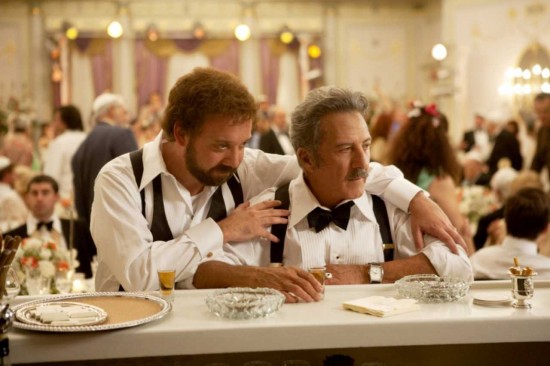|
The Comedy In Tragedy
Paul
Giamatti makes an unlikeable malcontent sympathetic in “Barney’s
Version”
By
Cristina Merrill / Jester correspondent
 Pictured:
Paul Giamatti with Dustin Hoffman, who plays his father in
“Barney’s
Version.” Pictured:
Paul Giamatti with Dustin Hoffman, who plays his father in
“Barney’s
Version.”
“Barney’s
Version”
is the tale of Barney Panofsky, a man who steadfastly digs his own
proverbial grave. His self-destructive nature is what drives the movie
and, oddly enough, makes Barney so interesting and even relatable. Paul
Giamatti displays his versatility as an actor – he makes his character
of Barney likeable and interesting, despite his many flaws (and there
are many). Barney drinks like a fish, smokes his heart and lungs out,
runs around in a constant state of dishevelment, and slacks off in all
three of his marriages. And yet, you cannot help but hope for Barney,
hope that he will change his ways, hope that the woman he loved – and
wronged – will take him back, or hope that he will reconcile with his
son. Such sentiment for such a flawed character can only be obtained
through a brilliant performance, delivered flawlessly by Giamatti and
supported by a stellar cast of characters. Barney’s Version is a
beautiful, moving film that will make audiences look inward.
The film opens with Barney sitting alone in his apartment, drinking and
smoking and calling his ex-wife’s husband, taunting him about how much
better she looked when she was married to Barney. This lonely state is
just a fraction of the misery in Barney’s life. He is estranged from his
son. A book has been written that portrays Barney as a prime suspect in
the death of an old friend. Other than that, Barney seems to have a
normal life. He lives in a beautiful apartment in Montreal, gets along
well with his daughter, drives a Mercedes, and owns his own production
company, Totally Unnecessary Productions. But he is clearly unhappy and
misses his ex-wife. The reason for their divorce is not immediately
clear, sparking curiosity. What brought this man to the sad and lonely
state he is in today?
Much of the first half of the movie is flashback, showing a young Barney
who marries twice during his drifting, clueless years. His first
marriage took place in Italy to a hippie-ish American girl (played by
Rachel Lefevre) who gets pregnant by Barney’s friend and tries to pass
the baby off as Barney’s. His second marriage to a wealthy girl (played
perfectly and quirkily by Minnie Driver) from his native Montreal is the
catalyst for the movie. It is never clear why he marries her, as they
have absolutely nothing in common other than being Jewish. They come
from different classes – her parents hate Barney and his cop father (a
solid performance by Dustin Hoffman). But marry they do, and it is at
their wedding where Barney meets the love of his life, his bride’s
cousin, Miriam, setting the stage for a tumultuous marriage that was
doomed from the beginning anyway. Barney pursues Miriam throughout the
course of his short marriage, much to her horror, but they finally get
together almost immediately after he signs the divorce papers.
Eventually, they proceed to get married, have kids – the whole shebang.
This is the happiest period of Barney’s life. But when their marriage
hits a rough spot (his own fault, really, as he neglects his wife’s
needs), he makes a huge mistake and has a one night stand. All hell
breaks loose when his wife finds out. Thus, Barney descends into the
worst phase of his life, for he has known real happiness and has lost
it. But whether he can reclaim that happiness is the question the viewer
is left to ponder. He continues to pursue his ex-wife in the same brazen
manner he did while he was still married to another woman. Nothing stops
or deters him, not even the onslaught of dementia. In one of the most
eerie and moving parts in the movie, and of Giamatti’s performance,
Barney proceeds to tear up his home in frustration because he is unable
to remember Miriam’s phone number. He is stopped by his daughter, played
coolly and sweetly by Anna Hopkins.
This is not to say that
“Barney’s
Version”
is a sob-fest. His story frequently tiptoes the fine line between
tragedy and humor. The best example of this is when his father dies
while having sex with a prostitute. Wavering between sadness and shock,
Barney takes his father’s hand and, before he knows it, bursts into
hysterical laughter.
Barney should be the character we love to hate and look down upon, but
he is not, thanks to Giamatti’s brilliant portrayal of a self-sabotaging
slacker. Barney is, in a sense, a vision of the self-destructive side in
all of us, the part of ourselves that ruins our opportunities and digs
our own grave. There is a Barney within all of us, whether we do not
take care of ourselves, whether we are stuck in an unfulfilling job, or
whether we royally mess up the love of our life. This is what makes
Barney’s Version a universal tale. It is the story of a man who has no
one to blame for his troubles but himself.
“Barney’s
Version”
opens Dec. 17
in New York and Los Angeles. |

